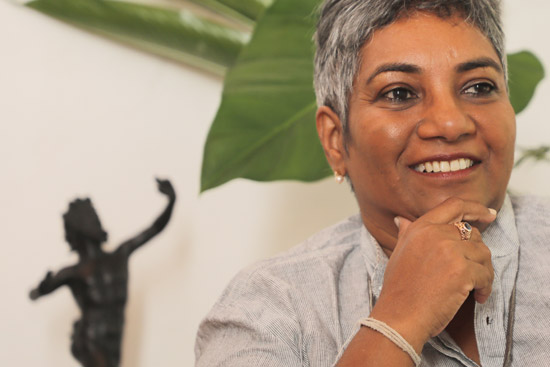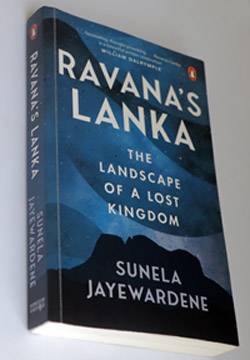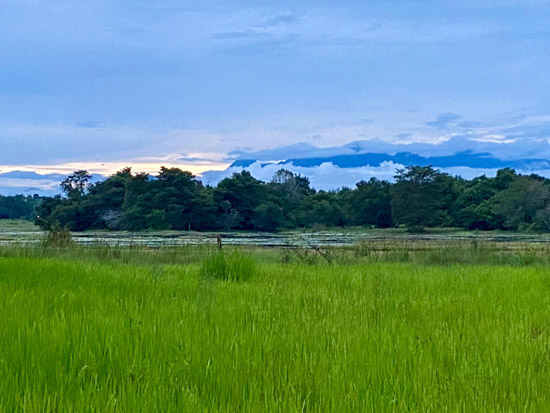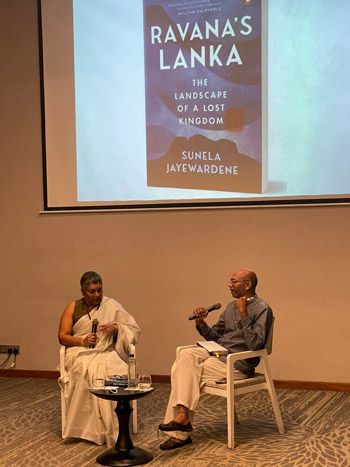A determined odyssey to where few have dared tread
Sunela Jayewardene was a child of the wilderness in that her extended family would regularly holiday in places like Wilpattu or Kumana where village trackers’ tales of pygmy men (the ‘nittaewo’) and extinct leopards (‘Lenama kotiyas’) thrilled her… She grew up fascinated by Lanka’s rural wilds and this was what has led her to become one of the leading environmental architects in the island.
Her love for our wilderness is her central passion, while architecture is but “a tool I use to conserve (that) landscape,” Sunela reiterates.

Sunela Jayewardene: Grew up fascinated by Lanka's wilderness. Pic by M.A. Pushpa Kumara
It was within the forests and plains and hills and beaches of Lanka, where she roamed with an unquenchable thirst for legend and lore, that she came upon tales of King Ravana. But mostly, this happened in Dunvila near Wasgamuwa, where in the Dumbara valley (the Knuckles Range) she had built her home, the villagers still talk of the war between Rama and ‘our rajjuruwo’- Ravana, as if it happened only yesterday…
 Such was the genesis of Ravana’s Lanka: The Landscape of a Lost Kingdom, a book that traces travels through Lanka’s lesser-known palimpsest landscape, peeling back obstinate layer after layer to let in more than a window of light from a pre-Vijayan world where Yakas (whose greatest king was Ravana); the Rakusas (who later became the Veddhas?) and the seafaring Nagas co-existed; a world from which conventional archaeology- and history- shies away…
Such was the genesis of Ravana’s Lanka: The Landscape of a Lost Kingdom, a book that traces travels through Lanka’s lesser-known palimpsest landscape, peeling back obstinate layer after layer to let in more than a window of light from a pre-Vijayan world where Yakas (whose greatest king was Ravana); the Rakusas (who later became the Veddhas?) and the seafaring Nagas co-existed; a world from which conventional archaeology- and history- shies away…
Of course, this book follows her first, The Line of Lanka shortlisted for the 2017 Gratiaen Prize, and elaborates on those captivating tales that toponymy and legend recount about the first inhabitants of our island- the yakas in particular.
Her narrative is poetic and the language robust, with lyrical metaphor and simile especially when describing the wild landscapes whether rolling plains in Nuwara Eliya where sambhur and leopard roam, or monasteries claimed by jungle tide but still breathing the tranquility of places touched by the long-ago Arahats.
The Kingdom of the Mayurangas to whose dynasty Ravana belonged is portrayed as having included even exotic Uzbekistan where Ravana’s traitor brother Vibhishana was originally sent as palatine, that country being part of the ten states over which Ravana the ‘ten-headed demon-king’ was lord. As Sunela points out, this was demonising of the conquered by the conqueror which happens especially when the vanquished party was particularly formidable and awe-inspiring.
Sunela’s Ravana is more Dravidian than Sinhalese and she builds up a strong case for a chronology where the very first inhabitants of the island were the Rakusas, while the Yakas came from Persia and the seafaring Nagas (coming from Burma?) occupied the land around waterways.
Amongst the places Sunela visited in search of evidence of Ravana’s sophisticated civilization, is Narang Thalawa in the Knuckles mountain range, where their guide Muthubanda from a nearby village leads them to “Ravana’s rail tracks”. While these metal tracks are not ‘bona fide’ railway tracks, says Sunela: “The best possibility that we could propose was a landing point for some form of aerial lifts- perhaps something akin to a cable car or chairlifts, as seen in ski resorts. Or even a zip line. A station with a terminal wheel that wound cable cars back and forth, we imagined.”
Raksagala is one of the most intriguing places Sunela visits. Her premise is that the Rakusas were the people who lived close to the land, who knew the plants and their properties, and fauna and the mysteries of nature being true aborigines. The Yakas who ventured here later imbibed that knowledge and held sway over them (the Rakusas).

Dunvila in the Dumbara valley: Idyllic landscape where tales of yore abound
In Raksagala, Sunela stumbles upon a number of curious discoveries; some 50 dressed stone caves and a stupa with a dish-like ‘chaththra’ instead of the usual spire appearing eerily outlandish. There is also the tomb of Arahat Mahinda shaped like a ziggurat.
One of the most telling tales of the sophistication of those early inhabitants of Lanka, is the story of the Gal Sohon Kanatte, located beyond the village of Rakogama in Kurunegala. In this cemetery of cist burials were found urns filled with soil, and when the soil was analyzed it turned out to contain a vast collection of plant species.

In conversation with Mirak Raheem: At the launch of her book on Thursday
And what were those plants? Coniferous hemlock trees, Larch pines, cypress, spruce, cedars, juniper and deciduous elms, and walnut and maple – this in dry zone Kurunegala! This clearly shows that trade with those temperate regions existed, and this more than 2500 years ago. It also speaks for sophisticated rituals whether such practices were limited to the nobility or indeed observed by all and sundry, including the commoners.
But for Sunela, one of the most serendipitous discoveries was the ancient Mahathiththa fort. With her characteristic imagination, Sunela evokes a truly cosmopolitan fort with “the plush robes of Persian merchants, with their braided and embroidered hats,… brightly coated Uzbeks… Armenians, Gujaratis, Maratha, Rajasthani, Afghans… brushed past Chinamen hurrying by in silks…”
The discovery that clinched it for Sunela was that, occupying the primary position in this fort, was a Shiva temple which meant the fort predated Buddhist Anuradhapura.
The book contains a wealth of such nuggets and Sunela does manage to conjure a shimmering spirit of those long-ago days.
Also of note is Sunela’s trip (as nearly always with husband Karu and also maybe daughters and friends) to Kudiramalai or ‘Horse Cliff’ or ‘Hipporos’- the harbour once so bustling with trade with its giant statue of a horse on a cliff, but today home only to pink dolphins, baobabs and wild beasts.
Amidst the many mysteries tied to that obliterated pre-Vijayan past of ours, is the Nalanda Gedige, rather Cambodian with erotic carvings and a sakwala chakraya or a ‘universe cycle’ or cosmological map.
So much more is packed into this book: the legends of Lakegala near Sunela’s abode Dunvila which is full of curious mementoes of Rama and Ravana’s war and the mysterious ‘Line of Lanka’ itself…
An immensely readable volume due to the author’s rich lyrical prose even while describing architecture and archaeology, Ravana’s Lanka is a fascinating story full of surprises and unexplored, wild nooks and crannies, a determined odyssey to where few professional archaeologists have dared tread…
Ravana’s Lanka: The Landscape of a Lost Kingdom was launched on Thursday, August 22 and is available at bookshops priced at Rs. 3,500.
Searching for an ideal partner? Find your soul mate on Hitad.lk, Sri Lanka's favourite marriage proposals page. With Hitad.lk matrimonial advertisements you have access to thousands of ads from potential suitors who are looking for someone just like you.


